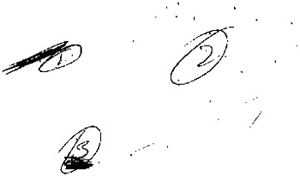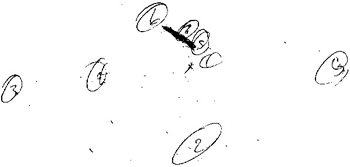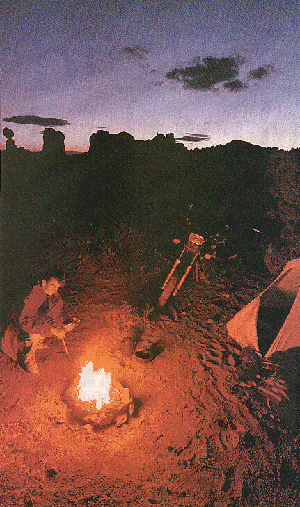 April 2001 CRV Direct Hit Featuring Lyn Buchanan by Dick Allgire There is value in the publication of raw remote viewing session work. It gives everyone a better understanding of what kind of data can be produced by a remote viewer, and it gives us a chance to see how data manifests in a real session on a real target. Too many claims are made about remote viewing without any data to back up those claims. Lyn Buchanan was kind enough to let us publish and analyze a session that he worked recently. In this instance the work was essentially blind. The partial frontloading was simply this: Target coordinates: 012301 018911 “The target is a location. Describe the location.” As he worked the session Lynn was monitored by John, with a student named Coral observing. Lyn Buchanan is not fond of “proving” his skill as a remote viewer to onlookers. Commenting on this session he says “Thinking back on it, I was somewhat perturbed. I hate Dog & Pony Shows. I have done too many of them, I guess. While I don't mind doing demos for the students, there is still that Dog & Pony Show feeling in the back of my mind that I can't get rid of.” We asked Lyn if uses any type of “cool down” prior to working a session. “I have found,” he replies, “that the best ‘cool down’ for me is to line up a series of physical activity jobs and just include the session in it, zooming through the jobs without break and as quickly as possible: Mow the lawn, Clean the garage, Do the session, Wash the car.” This session was done on January 23, 2001. We are publishing two complete versions of the session. Lyn first sent the unedited original, which is rather difficult to read. “Everyone who has seen me do a session,” he says, “knows that the handwriting is totally illegible, especially when I'm on target.” We requested he copy the session and provide a more legible version so everyone could better read and understand the data. Lyn sent us a typed version of the session with this caveat: “I'd like a disclaimer on it saying it was re-done for presentation, and that it had been compared to the original for accuracy. I don't know why, but I have always been a stickler for total honesty where the public is concerned. I'd hate for the word - - -or even suspicion - - - to get around that I was faking a target for presentation.” Here is the typed version of Lyn’s session:
Editor’s note: When we refer to page numbers here, we are referencing the typed, copied version. On Page One Lyn writes “POCD: Biker gang invading a town and destroying everything. “POCA stands for Previews Of Coming Attractions,” Lyn explains. “This is an advanced visual or advanced perception. It is data that occurs to the viewer prior to actually beginning the structured portion of the session.” Lyn says these pre-session impressions act as “attractors” during the session if you don’t put them aside. Also on Page One he writes “SA: biker gang.” SA stands for set aside. “It is a 3-step psychological process,” explains Buchanan, “which has been found to aid people in putting things out of their minds. Only the last step gets written down. Therefore, the POCAs and the POCDs (Previews Of Coming Distractions - such as expecting a phone call, hungry or cold, or any other expected distraction) can be "set aside" from the mind. The mind is then clear to start the session without dragging in the worries and cares of the day.” IDEOGRAMS CAN BE VERY COMPLEX I noticed that Lyn breaks his ideograms into several sections, and apparently probes different portions of each ideogram. He explains, “The theory behind ideograms was originally discussed by Rene Warcollier, and can be found among his works. An ideogram is a physical language, which your conscious and subconscious minds agree upon for communicating basic information. In reality, this language can become as complex as our everyday language. I have seen ideograms, which go on for several pages, produced by people who have very developed ideogrammic languages. Linguistically, a simple ideogram equates to a word. Its meaning is gestaltic, but it is a word, nonetheless.” Buchanan continues, “When you begin to gain proficiency in this physical language, your mind automatically starts producing compound or complex ideograms, which then equate to sentences or paragraphs. Just like in the English language, you can have simple, compound and complex ideograms.” “For general sessions,” he says, “most people only use simple or compound ideograms, because that is enough to get the session started and go on to the other techniques. When a compound ideogram is produced, it is possible for the viewer to feel along the line, find the dividing places, and break out the single words contained within the compound ideogram. Most viewers only produce simple or compound ideograms, but carried to its fullest, the ideogrammic "language" can become a full-blown language which allows the subconscious mind to clearly and without pollution, talk directly to the conscious mind about anything - even where you forgot those car keys.” STAGE TWO: WINKING AROUND THE SITE "In stage 2, your mind has just been dropped into a totally dark place. It has no idea whether it is in a lion's den, or on the edge of a cliff, or whether there is something at foot to stumble over, or what. It searches its resources and finds out that it only has a small, narrow-beamed penlight. So, it takes the penlight out and frantically begins shining it here and there, reporting back what it sees. It shines it upwards and sees something "red". It shines it forward and sees something "round". It shines it downwards and sees something "rubbery". The conscious mind is sitting there listening to all this and hears, "red", "round", "rubbery", and says, "OOH! I know what it is!! It's a ball!" In reality, it is only a site that has something red, something round, and something rubbery. Therefore, while you are in stage 2, you are "winking about the site" no matter how much organization you try to have. You cannot make sense of things being reported back from the subconscious, so don't try. Just record things and keep going.” “There comes a time,” Buchanan explains, “when you realize that this dark place is something you can relate to. I can deal with this, your mind says, and the panicky ‘winking about the site’ ebbs. Then, you shine your penlight at, say, the red thing, and begin picking up detailed information about it. The moment when you establish a relationship with the site is called the "Aesthetic Impact" (AI)., and indicates that you have moved into Stage 3.” ARE WE CONFUSED YET? CONFUSION BREAK On page three of the session you will notice Lyn declares what is called a “Confusion Break.” His explanation: “When something happens in a session to get the viewer confused, no matter what the reason, it is good to stop for a moment to let the confusion dissipate. Like everything else in the session, you note it in the report. You usually don't have to take a long break, so it isn't always necessary to log in the time you begin the break and the time you resume session. If you take a longer confusion break, you would do that.” STAGE FOUR MATRIX We noticed Lyn did not enter his data in Stage Four down and across, and asked it this is an indication that he is out of structure. “Somehow, the rule that you go across the columns has gotten misunderstood,” he says. “You begin in the sensory column and report sensories until you get dimensionals, then you move to the next column. The rule about going across the columns doesn't mean that you write one word in each and then move to the next. I don't know where that idea got started- probably from someone looking at a session and misinterpreting what they saw.” “However,” Buchanan continues, “that does bring up a very good point about CRV. The main rule in CRV, which I call the "prime directive" is that the viewer is in charge of the session. That means that everything and everyone is there to serve the viewer's subconscious mind in its attempt to get site information. That even applies to the protocols. The viewer is not there to be subservient to the protocols. The protocols are there to serve the viewer. Therefore, if it should occur (it very rarely ever does) that a viewer NEEDS to go "out of structure" to gain some bit of information, the prime directive overrides all other rules and does what is necessary. The viewer is not there to serve the protocols. The protocols are there to serve the viewer.” In this session Buchanan provides a very detailed and accurate description of the target, yet he produces almost no sketches. “ I rarely ever sketch,” explains Buchanan. “I almost always map. It is a personal trait.” “The problems with writing things on the map (or even on a sketch) are that (1) it clutters the map or sketch up, sometimes covering important bits of it and (2) when you go back and look at the sketch with everything labeled on it, you can't tell which impression was perceived first,” he explains. You will notice some of his sketches contain numbered circles. He says placing numbers where perceptions were gained serves two purposes. It keeps the sketches cleaner and less cluttered. And it documents the order in which the impressions were obtained. The analysis of this target gives Buchanan a score of 100%, meaning that all of substantial data provided in the session is congruent to the target. Says Buchanan, “This is not what people can expect to do every time, but what they can expect to do on a really good day. Our thanks to Lyn Buchanan for sharing this excellent example of remote viewing with us. Return to Home Page Copyright © 2001, H.R.V.G. All rights reserved. |
||||||||||||||||||||||||||||||||||||||||||||||||||||||||||||





